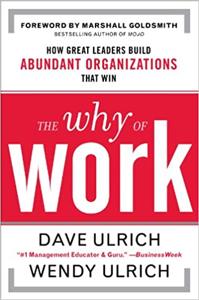
Want to learn the ideas in The Why of Work better than ever? Read the world’s #1 book summary of The Why of Work by Dave Ulrich, Marshall Goldsmith, Wendy Ulrich here.
Read a brief 1-Page Summary or watch video summaries curated by our expert team. Note: this book guide is not affiliated with or endorsed by the publisher or author, and we always encourage you to purchase and read the full book.
Video Summaries of The Why of Work
We’ve scoured the Internet for the very best videos on The Why of Work, from high-quality videos summaries to interviews or commentary by Dave Ulrich, Marshall Goldsmith, Wendy Ulrich.
1-Page Summary of The Why of Work
The Meaning of Work
Work is something people do to earn money, but it’s also a way of exploring one’s sense of meaning and purpose in life. People spend most of their time working, so work gives leaders the opportunity to connect with their employees and shape the underlying meaning behind what they’re doing, which will help them contribute more as individuals. However, finding meaning can lead to profit as well; meaningful work is inherently good for both you and your business.
In the workplace, there is a lot of boredom and monotony. However, this can lead to stress which affects people’s quality of life. There are many different factors contributing to this problem such as depression or an off-putting mindset that causes people to be less productive at work. The author believes that these issues stem from “deficit thinking” where people feel like they’re not getting enough out of their jobs and decide to slack off because they don’t trust others in the workplace.
On the other hand, companies that have a reason for existing and work towards it can create a virtuous cycle. Employees who are passionate about their company’s mission will do better work than those who aren’t. They’ll want to learn more and tackle challenges head on because they’re passionate about what they do. Additionally, these employees will be motivated by financial rewards since they love working at an organization with a purpose.
So how can organizations stop being places where people think only about deficits? How can they be sure that they’re focused on meaning in good times and bad? It takes leadership, of course, but it also requires a certain kind of leadership. Executives have to acknowledge their responsibility for pushing past the traditional role of focusing on outcomes and instead help employees learn, grow, and hope—in short, make organizations abundant by serving their customers as well as their workers.
The “Seven Drivers” of “Meaning Making” Leaders
Leaders drive the abundance agenda by asking their employees seven questions. These questions challenge and motivate them to find assignments that they are passionate about, which align with organizational goals as well as customer satisfaction. The seven questions are:
1. “What Am I Known For?”
When you ask yourself what your organization is all about, you are dealing with identity. This includes the signature strengths of your employees, their values and skills. When an employee has a strong sense of self, he or she can bring more clarity and energy to the workplace. Employees who know how best to use their talents will be able to do so when they understand themselves better. As a leader, it’s also important for you to figure out your company’s persona (its unique characteristics) as well as its greatest abilities and align individual employees’ targets with those goals in order to serve customers better. You should rethink or reinforce corporate agendas by parsing out identities such as that of your employees, customers and even investors so that everyone knows where they stand in relation to one another. Do you have the right people working on projects? Are priorities clear? Is there alignment across teams?
2. “Where Am I Going?”
Employees have different goals. Some employees are more interested in insight, while others want to achieve something or connect with other people. Leaders must align their employees’ goals with the organization’s goals so that they can work together for a common cause. At the same time, leaders need to help their employees meet minimal criteria and complete tasks that are worth doing but may not be done well enough. For example, you might satisfice on yard work by putting in maximum effort on tasks that really transform your business versus doing the bare minimum of work to keep your business running without transforming it. If handled intelligently, satisficing provides “direction and purpose.”






